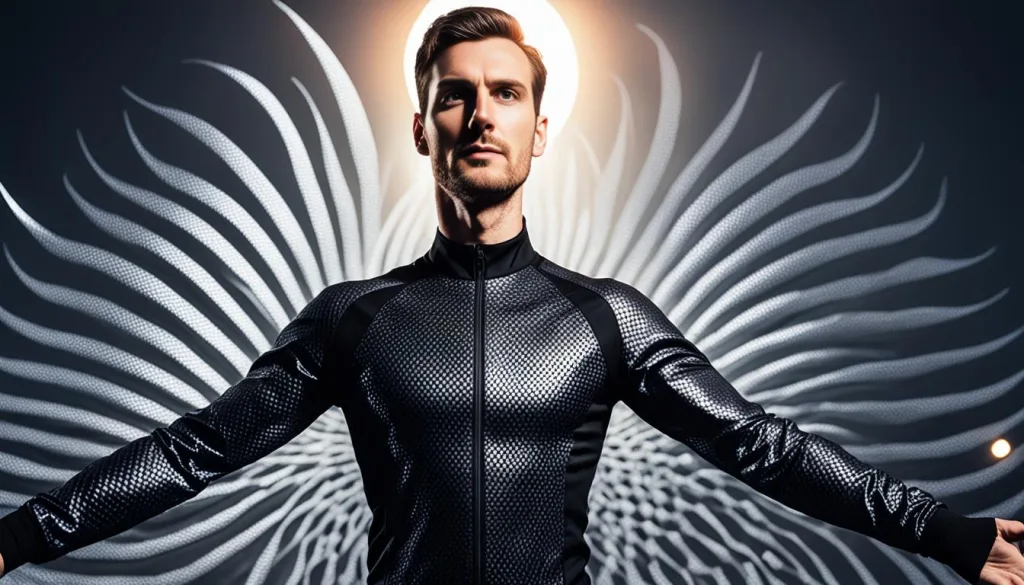Keeping Cool: Innovative Fabric Technologies for Summer Sportswear
Connect With Us Today
Consider us for your next production run. Why wait? Send us your questions here.
As summer comes, athletes and fitness fans look for sportswear that keeps them cool. They want innovative fabric technologies for summer sportswear that grow in popularity. With an expected growth of about eight percent by 20321, these are not just clothes.
The moisture-wicking materials and breathable sportswear offer more than comfort. They show how far we’ve come in making performance fabrics that help athletes do well in the heat. Especially, advanced cooling technology like brrr° Pro and 37.5® Technology set new high marks. They cool athletes well by moving heat and moisture away from the skin1.
Key Takeaways
- Advanced technologies are shaping the future of summer sportswear with fabrics that keep athletes cool.
- Moisture-wicking materials and breathable designs are at the core of innovative sportswear.
- Performance fabrics equipped with brrr° Pro and 37.5® Technology provide superior cooling by managing heat and moisture1.
- Advanced cooling technology in sportswear is integral for peak athletic performance and comfort.
- Market trends indicate significant growth in cooling textiles, highlighting their increased importance in sportswear design1.
History and Evolution of Cooling Fabrics in Sportswear
The journey to enhance comfort in sportswear has led to cooling fabrics. These keep athletes at the perfect temperature. It’s a story of merging style with functionality, through innovation and science.
The Space Age Beginnings: NASA’s Influence on Athletic Fabrics
NASA’s tech has transformed the athletic world. What was used in space to protect astronauts now helps athletes stay cool on Earth. A groundbreaking research paper was shared in ACS Nano on August 10, showing this exciting progress2.
From Weighted Blankets to Sportswear: Temperature Balance and Abatement
Temperature balancing technology has evolved from its start. It went from weighted blankets to sportswear that controls temperature. Thanks to phase change materials, people like firefighters to farmworkers face less risk in extreme temperatures2.
Emerging Innovations: Phase Change Materials in Performance Wear
Phase change materials (PCMs) lead the way in sportswear innovations. They’re used in gear that can store and release heat. This offers athletes adjustable temperature control2.
Challenges like hardness and potential leaks have been tackled. Modern methods like coaxial electrospinning wrap PCMs in nanofibers. This adds flexibility and strength to the fabric2.
The ‘trimode’ textile is a game-changer. It blends PCM with light-reactive and electrically conductive elements. It provides tailored comfort to athletes, adjusting to different temperatures2.

Understanding Temperature Balance Technology in Sportswear
Sportswear has changed a lot because of new technology. Now, companies use moisture-wicking materials and sweat dispersion techniques. These innovations help athletes stay comfortable and control their body heat better.
Brands like Nike and Adidas use special polymer treatments in sportswear to keep athletes cool. They get ideas from new research and trends. Products like Nike’s Dri-FIT and Adidas’s Climacool have made a big difference in how athletes manage their body heat during tough workouts.
Moisture-Wicking Materials and Sweat Dispersion Techniques
Innovative fabrics pull sweat away from the skin, helping you cool down through evaporation. For example, the DUER Crop Tee uses TENCEL Lyocell and cotton to promote cooling and stop bacteria from growing3. Bamboo, used in the Kora SS crew T-shirt, shows how natural fibers can be effective. It offers UPF 50-plus protection and wicks moisture away3.
Polymer Treatments: The Science Behind Nike Dri-FIT and Adidas Climacool
Nike’s Dri-FIT and Adidas’s Climacool include making fabrics that let air flow better. They also add special coatings to match how athletes sweat. These technologies keep the fabric dry and prevent discomfort from sweat. This helps athletes stay comfortable and perform at their best.
Let’s look at some top products that use these technologies:
| Product Name | Cooling Technology | Material Composition | Additional Features |
|---|---|---|---|
| Weightless Poplin AC Pant | coldblack fabric | UV protection, reflective properties | Reduces heat absorption compared to regular clothing3 |
| Forloh Hoodie | Brrr Pro technology | Quick-drying abilities | UPF 50-plus protection, cooling & quick-dry up to 300%3 |
| Livsn EcoTrek Shorts | Water-repellent | 70% recycled ocean buoys material | Quick drying, environmentally conscious design3 |
| Arctic Cool Crew Neck T-shirt | HydroFreeze X Technology | Moisture-wicking, Cooling | UPF 50-plus protection3 |
Sportswear brands work hard to make fabrics that are comfy and fight the downsides of synthetics like polyester. They choose and treat fabrics carefully. This is key in making sportswear that meets an athlete’s need to stay cool3.
In the end, technology that balances temperature is a mix of science, human body needs, and fabric design. It’s very important for athletes who want the best performance and comfort. The sportswear market today offers many cooling solutions.
Advanced Cooling Technologies: Fabrics that Beat the Heat
Summer sports fans and outdoor workers seek new ways to stay cool under the hot sun. Construction, manufacturing, and outdoor activities have a high risk of heat-related illnesses from being in high temperatures for long4. If you start sweating a lot and get muscle cramps, it might mean heat stress is starting4. The latest fabric technologies are key to fighting these issues. They offer protection and comfort.
These amazing fabrics use new materials and designs for unbeatable cooling effects. They’re part of a big plan to stop heat stress, including drinking water and scheduling work right4. We’re exploring cutting-edge technologies to show how new fabric tech is helping safety and boosting performance.
Heat-Conductive Graphene in Athletic Apparel
Graphene is at the forefront, known for moving heat well. In sports clothes, it helps get heat away from your body quickly. This makes athletes cooler and helps them do better.
Metafabrics: Combining Reflective Properties with Breathability
Metafabrics are another big step. They blend being reflective and breathable, which helps keep you cool in two ways. The fabric reflects the sun and lets air through to evaporate sweat. This is crucial to avoid getting too hot4.
HydroActive™ Technology: Evaporative Cooling in Action
HydroActive™ technology is a top evaporative cooling method. It uses special fabrics that cool you down fast when they get wet. It’s leading the way in cooling technology, with materials that change phase and panels that keep your body at a safe temperature4.
“The integration of HydroActive™ technology into protective wear signifies a leap forward in safeguarding our workforce and sportspersons from the invisible threats of heat exposure.”
Heat-resistant clothing is key for work in very hot places like foundries or steel mills. These clothes are made to handle extreme heat, radiant heat, and molten metal splashes4. They also let your skin breathe and manage sweat, making them a full safety and comfort solution.
Improving how we prevent heat stress never stops. It’s about more than just special clothes. Using cooling devices, planning work carefully, and watching the weather helps keep workplaces safe4.
The new fabric technologies, like graphene, metafabrics, and HydroActive™, are changing how we stay cool and safe from heat stress. With ongoing advances, we’ll see these smart fabrics more in our everyday clothes, keeping us cool as temperatures climb.

Future Trends: Dynamic Response Fabrics and Beyond
The sportswear industry is booming, with a global value of about $161 billion5. It’s getting a makeover with high-tech fabrics that promise better performance and comfort. Dynamic response fabrics and smart textiles lead the way. They blend style with function to meet consumer desires.
These advanced materials mix style and technology5. They combine popular synthetic fibers with cutting-edge tech that adjusts to the environment. Intelligent textiles even change structure based on temperature changes. This keeps athletes at the perfect temperature.
Intelligent Textiles: Fabrics that Adjust to Environmental Conditions
Keeping cool and dry is a big deal in sports gear5. Smart textiles tackle this by reacting to the environment. They adjust moisture and heat based on how much you sweat, from a little to a lot.
Carbon Nanotube Infusion for Temperature Gating
Carbon nanotube infusion is the latest trend for regulating temperature in sportswear5. These tiny additives boost moisture control. They’re added to stretchy, breathable fabrics, helping athletes stay dry.
Scaling New Fabrics from the Lab to Commercial Production
Bringing lab-made fabrics to stores is tough5. These include dynamic fabrics and those with carbon nanotube. Experts must balance cutting-edge design with mass production to impact the $73 billion U.S. sportswear market.
The future of sportswear is about merging beauty and tech5. Designers and scientists aim to make clothes that not only look good but respond to the wearer’s needs. This will start a new chapter in sportswear innovation.
Conclusion
In the summer sportswear world, moving from old ways to new fabric tech is a big leap forward. Now, with88 percent of U.S. homes having air conditioning, staying cool is important6. The design of old houses with wide porches helped back then6. But now, we have new fabrics for sports clothes that help keep us cool during sports.
The textile field has seen huge changes with inventions like the spinning jenny and, later, with 20th-century science. These changes brought about fabrics that are key in sports clothes today7. These fabrics aren’t just from a long history of textiles but also reflect trade changes, what people like, and the latest research7. Now, sportswear uses these advances to make materials that wick away sweat and let our skin breathe, making a big shift from old cooling ways to effective, specialized clothes.
This article outlines how the past shapes our future, making athletic life more comfortable and efficient. The main points show that dealing with heat is more than just beating it—it’s about the advance in fabric tech. Looking at how comfort, science, and design meet in sportswear shows us the field’s future looks bright, with exciting new fabric technologies on the horizon.
FAQ
What are moisture-wicking materials?
How do sweat dispersion techniques work in sportswear?
What are polymer treatments in sportswear?
What is heat-conductive graphene in athletic apparel?
How do metafabrics combine reflective properties with breathability?
How does HydroActive™ technology provide evaporative cooling?
What are dynamic response fabrics in the context of athletic apparel?
What are intelligent textiles in the realm of sportswear?
How does carbon nanotube infusion enable precise temperature gating in fabrics?
What are the challenges involved in scaling new fabric technologies from the lab to commercial production?
Source Links
- https://www.ispo.com/en/sustainability/textile-trends-climate-change-5-fabrics-keep-you-cool
- https://www.sciencedaily.com/releases/2022/10/221011105806.htm
- https://www.cnet.com/health/personal-care/dont-sweat-it-these-clothes-can-help-you-stay-cool-even-during-a-heat-wave/
- https://www.premiersafety.com/blog/cool-protected-beat-heat-stress-with-protective-clothing/
- https://www.mdpi.com/2673-7248/3/3/22
- https://www.history.com/news/11-ways-people-beat-the-heat-before-air-conditioning
- https://en.wikipedia.org/wiki/Textile
Latest News
How Collaboration Shapes Consumer Preferences in Sportswear
Navigating Consumer Rights and Warranties in Sportswear Sales
Artificial Intelligence in Fashion Forecasting and Trend Analysis
The Shift Towards Inclusive Sizing in Sportswear: Consumer Reactions
The Global Expansion of Luxury Sportswear Brands
From Sketch to Gym: The Design Process of Fashionable Sportswear
Understanding the Role of Trade Associations in Sportswear Compliance
How Economic Trends Influence Consumer Spending on Sportswear
Learning from Successful Global Market Entries
Best Practices for Managing Cross-Cultural Teams
Using Technology to Fight Counterfeit Fashion Products
Carbon Nanotube Fabrics for Superior Strength and Flexibility
The Growth of Fitness Tracking Apparel in Health and Wellness
Exploring the Influence of Social Proof in Sportswear Purchasing
Strategies for Managing Compliance in a Multinational Operation
Trends in Global Footwear: Performance Meets Lifestyle
The Role of Artificial Intelligence in Tracking Supply Chain Operations
Evaluating the Success of Sportswear Collaborative Projects
Evaluating the Potential of Emerging Markets
Global Shifts Towards Gender-Neutral Sportswear
Share This Article
Latest Articles



















